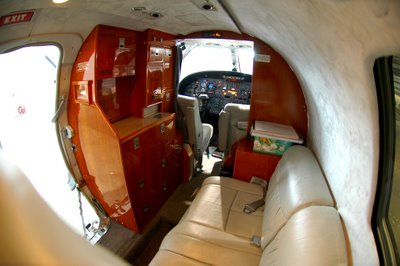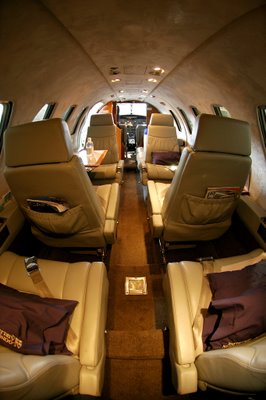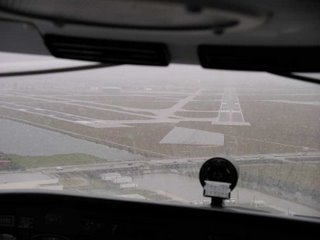

Lake Athabasca in Northern Saskatchewan. I was based there for a year and a half.
It's Monday and I'm in the office, doing paperwork and more paperwork. Today I'm looking for an avionics shop to add TCAS to our jet that doesn't have it, a-woo-hoo. TCAS is the magic box that lets you see other airplanes (assuming they have transponders) around you and lets you know if they present a risk of collision as you fly merrily from one place to another.
Later on I get to file a stack of papers about a foot high, and then perhaps I'll end the day by working on the company website, which is pretty sad in it's present incarnation. That should be amusing as I really don't know much about HTML.
Anyway, here's a story from the summer of 1998, when I flew Navajos and Barons in Northern Saskatchewan for Northern Dene Airways, whose owner has since sold the operation to Transwest Air in Saskatoon.
I was based in Uranium City at the time, living in the trailer that was attached to the terminal building. Uranium City is on the west end of Lake Athabasca, which straddles the Saskatchewn - Alberta border in northern Canada; Fond du Lac is 50 miles east, along the lakeshore, and then Stony Rapids is 50 miles east of Fond du Lac, near the east end of the lake.

Now a little bit of back-story is important: Fond du Lac was a dry community, meaning that no alcohol was allowed. Uranium City was not a dry community, and if you take the leap of imagination required to label a small broken-down trailer as a bar, then it had a bar. It also had a thriving bootlegging business going, and if you still had money left over after paying $6 for 2 litres of milk, then for an additional $50 you could purchase 12 beer or a 375ml bottle (a "mickey") of hard liquor from the owner of the general store. A lot of the economy of Fond du Lac (and surrounding communities) was a result of the uranium mines nearby, so on paydays we generally had a lot of charters from Fond du Lac to Uranium City, then back to Fond du Lac where the passengers would ask us to drop them off at the far end of the runway so they could run into the bush with a backpack full of goodies instead of walking by the main terminal where the local RCMP might be lurking.
Anyway, it was my 27th birthday, and I was sitting behind the counter of our terminal in Uranium City, thinking about the other 99 billion places I would rather be, when two men walked in. They were scruffy, dirty and carried a woman and 2 bulging knapsacks. I could smell the booze on them even before they made it to the counter, where the two men propped the woman up so she didn't fall over.
"We want to go back to Fond du Lac"
"I'm sorry, but you are drunk and I'm not going to fly you until you are sober"
-- Previous experience had made me leery of drunk passengers, like when I was punched in the back of the head by a few members of a softball team after I told them not to wrestle in the aisle of the Navajo on the way from Lac Brochet to Stony Rapids. After I got punched I dropped a wing of the Navajo until I heard screams in the back, and they buckled in and remained under control until we landed in Stony, where they peed in nearly all the seats on their way out the door --
"I'm just stoned, I'm not drunk", the woman helpfully slurred.
"No, I'm not going to do it"
"But I already paid you guys" - One of the men reached into his pocket and pulled out a crumpled receipt indicating that he had in fact already paid the Chief Pilot for a return trip to Fond du Lac.
Dwayne, the Chief Pilot was in a nearby hangar doing some unauthorized maintenance on a Navajo (I'm pretty sure you need some sort of formal training to be an AME, but that's another story) so I went there and brought him back into the terminal, fully expecting him to back me up.
He got there, took a look at the two men and the woman, who was now passed out in the only chair we had at our terminal, and said "Sully, they paid. Do the trip."
I had 300 hours at the time, and he made it clear that if I didn't do the trip, my next flight was going to be down south with my belongings where I could look for another flying job. I am ashamed to admit that I bowed to his pressure. Hey Dwayne, I still owe you an enthusiastic groin-punch for that one.
The two men and I carried the woman to the airplane and the three of them strapped in. I loaded their backpacks into the nose of the Baron and we launched for Fond du Lac.
It's a 15-minute trip from Uranium to Fond du Lac, and all was well for the first 10 minutes. I had just started to reduce the power on the Baron's engines and set up for the approach into Fond du Lac when I heard a commotion in the back. I turned aruond to see the woman raking her nails across one of the men's faces, leaving huge bloody streaks as they sliced his skin and flesh. The other man cowered in his seat, attempting to be invsible to the crazy sharp lady.
"STOP THAT OR I'LL CALL THE RCMP ON MY RADIO!" I bellowed.
Surprisingly, it actually seemed to work, and the lady detached her talons from the man's face.
I started my final approach to the gravel runway in Fond du Lac, and touched down uneventfully.
"Pilot, can you stop at the end of the runway"
"Yeah, sure"
It was late in the day and there was no other traffic nearby and nothing due into Fond du Lac until the next day, so I knew it was a safer option than saying no and taking a fingernail in my eye. In the B-55 Baron, the main cabin door is on the copilot's side, and it opens over the wing. You step out and walk toward the back of the wing, over the flap and onto a final step before stepping down onto the ground. This has significance in a few moments.
I stepped out of the plane, and went to the nose, where I popped open the nose door and retrieved the booze-filled backpacks. The man with the clawed face stepped out of the door, and started walking to the rear of the wing. The woman lunged out and pushed the man, and he fell face-first, tumbling into the dirt just behind the airplane. That wasn't the worst part. The worst part was when he tumbled, his limp body hit the right wing flap, and it broke the flap acutator arm. That meant the right wing flap was still attached to the rails, but it now hung fully down from the aircraft, with no way to retract it back into the wing.
Despite their obvious intoxication, all 3 passengers realized the significance of this, and also their financial liability. The 2 remaining pax jumped out of the plane, and the clawed man brushed himself off, they picked up their backpacks and disappeared into the bush in perhaps a microsecond.
"Sorry, pilot" was the last thing I heard as they departed at high speed.
At the terminal there was a payphone. I used the last of my spare change to call Uranium City, and got ahold of Dwayne.
"Umm, ICM is broken. The drunk lady pushed a guy onto the flap and now it's just hanging down."
He paused a while, then came back with this:
"Well, I think if you get going fast enough, the flap should tuck itself back into the up position and it should be okay for the flight home"
I'm not even kidding, he actually said that. Now even with my 300 hours and insecurity about my job security, I wasn't going to commit suicide.
"No way. The flap might tuck itself back up into postion, or it might just rip vibrate and flutter and rip itself from the aircraft and that leaves me with 20 square feet less wing on the right side and a plane that wants to roll over on it's back. At the very least please send over Randy in the 172 so he can put some speed tape on it for the return flight to Uranium"
"You don't want to fly the plane back now, you can sit there"
And he hung up on me.
Now there are certain northern communities that are very friendly to outsiders, and will do whatever they can to help a fellow human being in distress. Fond du Lac was not one of them. I had been warned in the past not to leave the airport grounds; "If you head downtown, you better bring a bag of rocks to defend yourself" was a quote I still remember to this day. It also didn't help that downtown was a fair walk from the airport, and I had no bug jacket with me.
I got into the back of the plane, opened up the survival kit and took out a blanket. I got into the back of the airplane with the blanket and waited. I watched the sun go down around 11pm (it was summer) and munched on a couple of the granola bars I had stored in the airplane in case I ever needed a quick lunch. I sang happy birthday to myself and hoped that Dwayne would be kind enough to tell my then-girlfriend in Uranium City why I wasn't coming home that night.
The night passed uneventfully, but I didn't sleep very well. The back of a B-55 is too small to stretch your legs and I kept hearing strange noises outside. Around 8am, just as I was thinking about walking into town and gettng the RCMP to fly me out on a mental health certificate, I heard a faint buzz which became the noise of our company 172 coming in to land. It taxiied over to me and shut down, and Randy (one of the few of our company mechanics worth a damn) hopped out.
He told me he had offered to leave the night before but Dwayne said he wanted to teach me a lesson, so he had to wait until this morning to come rescue me. We tucked the flap up and he slapped a few strips of speed tape on it, securing it for the 15-minute flight back to our maintenance base in Uranium City. He fired up and I gave him a 5-minute head start in the 172 before I launched in the Baron. I caught up with him before we landed, and we had a great time playing tag on the approach into Uranium City, skimming over the surface of the big lake on final approach. I only wish I didn't have to land and face the wrath of Dwayne for making him non-rev the 172 to come get me and spending the $30 on avgas. I loved the flying when I worked for NDA; it's just too bad the owners were such complete doorknobs.
More to come later...
























